
I expected my first event of the year to be the big New England Randonneurs Populaire on April 20th. But on a whim, this past Sunday I took part in a 100K Permanent to the Haystack Observatory in Westford, MA. I will save you the suspense: I did it on the clock and finished within the time limit. Counting my trip to the start and back, it was an 82 mile day.
In randonneuring vernacular, a Permanent is an officially sanctioned brevet route that can be ridden at any time (with some notice), rather than on a specific date on the established brevet calendar. Members ofRandonneurs USA (RUSA)can design their own Permanent routes of either full brevet(200K+) or Populaire (50-150K)length, and submit them for approval. The routes are then available to any member who wishes to ride them for RUSA credit, either alone or in a group. As with standard brevets, the time limits, control stops and other rules apply.
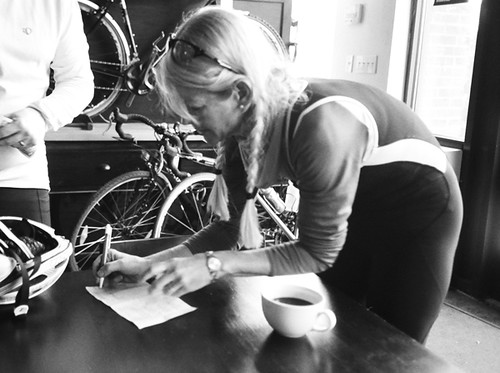
Local randonneuse Pamela Blalock has recently put together an entire series of such routes. About 100K in length starting from Lexington, MA,Pamela's Permanentsare best enjoyed as group rides and have some special features. The routes are circuitous, with a strong focus on back roads. And each route is designed around a theme destination and theme food stop. The idea is to stop at the destination long enough to enjoy it, and stop at the food stop for a sit-down meal - while still making the official cutoff times. The Haystack 100K would be the inaugural ride in this series, and I was excited bythe destination. This was my main motivator in attempting this ride so early in the year.
Having decided to try the brevet, I did not feel especially nervous. The idea of starting from a familiar place (our cycling club's "club house"), with indoor facilities and hot drinks, was comforting. Isigned up for RUSA membership the day before. On the morning of, I pedaled to the start slowly and arrived early, giving myself time between my trip there and the ride itself.

At 10:30am on a colder-than-promised morning, a small group of randonneurs had gathered. Sheepishly standing beside them was I: by far the weakest, feeblest rider present. While I braced myself for a challenge, they had clearly prepared to enjoy a relaxing little jaunt. The disparity was too hilarious to feel bad about, so I didn't. But neither did I expect to see the rest of the group for most of the ride.
We started out together, led by Pamela and Jon D-the only riders there I knew. Just for laughs Pamela was riding a fat tire cyclocross bike and Jon a vintage fixed gear. There was an experienced-looking couple on a tandem. There was a man who I was told was an exceptionally strong rider, on aRivendell3-speed with swept-back handlebars. The other two men and myself rode skinny tire roadbikes. I stayed quietly in the back, behind a fit-looking gentleman astride a Serotta.
One of the roadie men went on ahead about a mile in. The rest of us stuck together for about 10 miles. I was amazed that I was able to hang on for that long. But in truth, I was over-exerting myself for a long-haul ride, so I decided to fall back. At around the same time, the Serotta Gentleman pulled over to the side of the road to make some adjustments to his bike. And so our group split up.
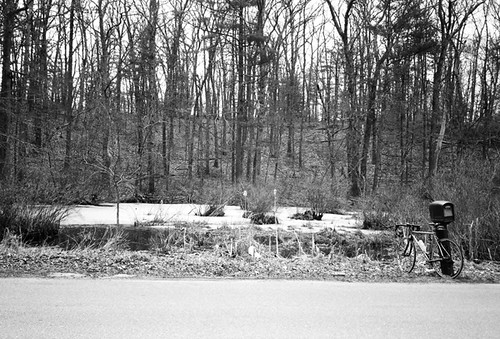
For a while I rode on my own. This was a welcome break after struggling to keep up with the group, though I still tried to ride as fast as I comfortably could, without stopping. The weather encouraged this. Though the forecast predicted temps in the 50s, I had not trusted it and now I was glad of that. The day was bleak and cold (that's ice and snowback there in the bog) with gusts of wind strong enough to push my bike sideways. Luckily, my dressing strategy had me well prepared. Instead of wearing a warm winter jacket, I had worn a thin wind vest, paired with an equally thin windbreaker over it. This layering protected from the wind chill while also allowing me to pack minimally, since each of these garments could be stuffed in a jersey pocket had I needed to remove them later. I packed a small under-the-saddle wedge with tools, spare tube, extra snack, etc. I started out with two full waterbottles with some electrolyte/energy powder mixed in. I also brought lights, just in case. And scotch tape.
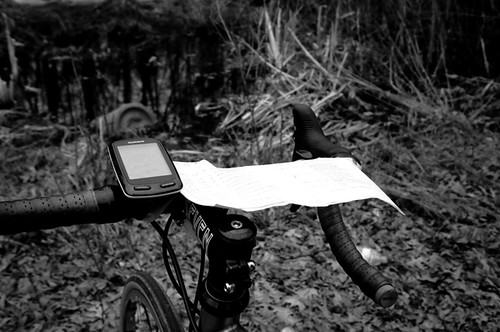
The scotch tape was in case I'd need extra to secure my cue sheet. As inelegant as the setup looks, this is my preferred cue sheet location (even if there is also a nice handlebar bag with map case attached!). This was my 5th ride following a cued route, and by now I know that (1) The paper cue sheet is a must, even if I have a GPS unit, and (2) In order for the cue sheet to be useful, it must be in a location that allows me to process the text at a quick glance. I hope to elaborate on all of this in a future post.
Navigating on my own was fine, with the exception of a confusing area around the first control, where I managed to go off course, lengthening my overall distance by about a mile. Here I should mention that the Haystack Permanent route was unusually rich in controls for a short brevet, which I suspect will be he case with all of Pamela's Permanents. It has to be, by virtue of the back roads design. The circuitous route creates potential short cuts, and control points ensure riders don't take advantage of them.
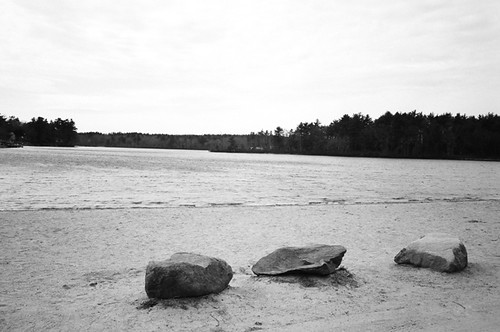
Contrary to what I had assumed, the control points were not at convenience stores or gas stations (in fact, I don't think we saw any of those for most of the ride!), but at completely random places in the middle of nowhere. Our brevet cards contained secret questions, and we had to search for the answers. This was not unlike a scavenger hunt, although I admit it would have been more fun in warmer weather. The coldest point of the ride was at the second control, by the side of a lake. The wind was so strong here, I could hardly hold the pen and brevet card in my hands. The light had that eerie deep-winter look to it - almost as if it might start snowing!

Soon after the second control, I noticed that I was over 20 miles into the ride - I had done a third of it. Just then, the sun came out briefly and somehow I knew that I would finish just fine. I was feeling good and fresh, despite the respectable amount of climbing. The route was described as having +3513ft of elevation over the course of 62.3 miles, and that felt about right. I thought the climbs were very humane: Just steep and long enough to require my lowest gears and some effort, but not so sharply pitched as to make me ill with that awful feeling of all the blood rushing to my head.
Which is not to say there wasn't suffering. I had determined not to bring my big camera on this ride, to ensure I'd take it seriously and do it on the clock. However, at the last moment I couldn't help it and snuck a tiny 35mm point and shoot into my jersey pocket, loaded with a roll of black and white film. I made an agreement with myself to only take pictures at the controls, where I would already be stopping, and so far I had stuck to this. But oh how I suffered through it! I suffered at the sight of dilapidated barns, rusty farm equipment, overgrown bogs, ice-covered fields, erratically winding roads. I settled into my pain and dealt with it.
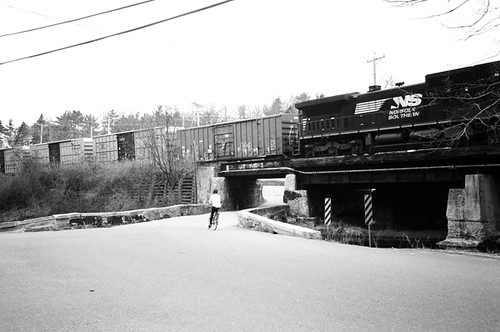
But after all, I am only human. When I paused at an intersection to double-check my cue sheet, the sight of a river crossing under some ancient train cars proved too much. I took out the point-and-shoot and snapped away in a hurried frenzy. Just then I spotted the Serotta Gentleman in my view finder. He slowed down and soft-pedaled, in an invitation for me to join him. Coming up on the next control and the brevet's main attraction, I warned my new companion of my picture-taking plans there. He was amused but unfased. From that point on, we rode together.
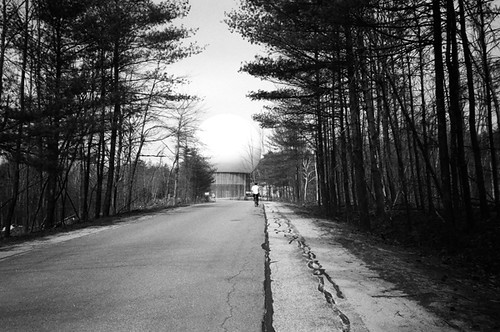
The MIT Haystack Observatory is situated on an enormous campus that is home to a couple of climbs. The first one leads to the Westford Radio Telescope (pictured here), and the next one leads to the main research facility and the Haystack Radio Telescope (first image in this post). Cycling uphill with the telescopes looming gloriously on the horizon, framed by thick growths of pine trees, was a breath-taking, unforgettable experience. This alone made the entire ride worth it.

The Haystack observatory was built in the 1960s, as a collaboration between MIT'sLincoln Laboratoryfor the US Air Force. It is an astronomical observatory, containing two telescopes and vast research facilities.
 There are also several enormous antennae - some functional and others abandoned, rusting in the nearby woods.
There are also several enormous antennae - some functional and others abandoned, rusting in the nearby woods.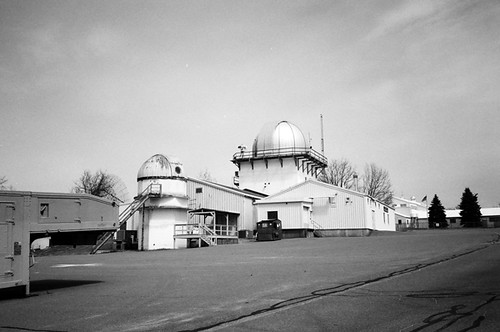
The research campus contains several interesting buildings - as well as military structures and vehicles. I will definitely return with some proper camera equipment.
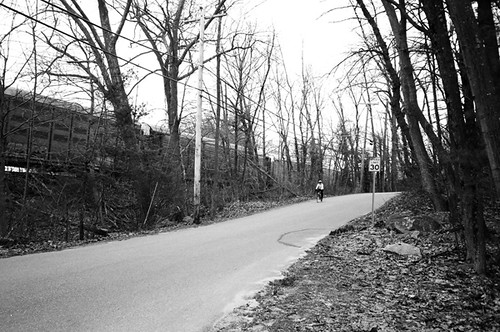
Having passed the Haystack, we were roughly half way through the brevet. Things sped up, as we rode straight through the next control and to the food stop at mile 45. Cycling with the Serotta Gentleman felt like drifting in and out of a shared stream-of-consciousness. Sometimes we rode side by side, sometimes we rode one in front of the other, sometimes we rode spread out, while still keeping each other in sight. Sometimes we were silent, sometimes we talked, in fragmentary conversations that had no clear start or end. All this was an oddly natural and meditative experience, despite our being strangers. According to our computers, we rode faster than either had expected - which surprised us, especially considering the winds, the climbing, and the occasional cue sheet misinterpretation. Only when we approached the food stop did I begin to feel tired. But the sight of the main group of riders renewed my energy. They were leaving just as we were arriving, and all were glad to see the group together once more.

The themed food stop for this ride was at Gene's Chinese Fladbread Cafe inChelmsford, MA. While the name suggests some sort of contemporary fusion cuisine establishment, in actuality this is a very traditional place that serves a variety of dishes prepared around large, gooey noodles, made from scratch on the premises. The atmosphere was delightful: Chinese families enjoying a late Sunday lunch, and a bunch of us cyclists. The owner seemed well used to issuing receipts and signing brevet control cards!
Praising the food, Jon D. suggested we get the #4 Special, and we followed his advice. This dish turned out to be a generous bowl of garlic, which also contained a handful of said noodles. I am still not sure whether this meal recommendation was sincere, or a practical joke played on us stragglers. Drivers must have steered well clear of us on the final leg of the brevet, so mighty was our garlic breath!

It is unusual for me that a second half of a long ride goes by faster than the first. Typically it is toward the end that the aches begin, the difficulties, the tiredness, the tedium. At some point, each climb grows more unpleasant than the last, irritation sets in and enjoyment diminishes. This time, none of that happened. We had the sense that time flew, and we flew. Though the climbs kept coming until the very end, they did not bother me. That is not to say I was fast, only that I really did not mind the climbing. If anything, it was the descents that were my weakness. There were a few spots on this ride with tightly winding downhill stretches, that I am not skillful enough to navigate without reducing speed considerably. As far as safety, this is where my GPS unit was extremely helpful: I could see the curves coming up and regulated my speed accordingly.

The finish snuck up on us. Pamela managed to route the final leg of the ride through a stretch of back roads I did not immediately recognise. And before I knew it, I saw there were no more cue sheets and my computer stated we'd ridden over 60 miles. Several miles later, we turned the corner to see the Ride Studio Cafe just down the street. Reeking of garlic and quietly beaming with satisfaction, we wheeled our bikes in at 5:00pm on the dot to submit our tattered control cards.
My computer read 64.3 miles at the finish, and 6.5 hours had elapsed since the start. That's an average speed of 9.9 mph, including all stops and the sit-down meal. My average moving speed over the course of the ride was 13.2 mph.
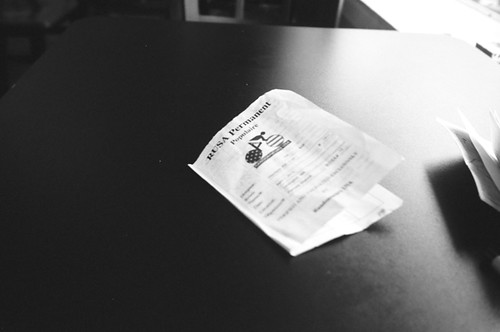
After handing in my control card, I hung around drinking tea and babbling excited non-sense for a half hour, then cycled home. After an 80+ mile day, I felt suspiciously fine. I got home before dark, washed, changed, and went out for a nice evening walk with my husband. I kept expecting the exhaustion and pain to hit me, but it never did. The next day was very busy, but I had no trouble waking up before 7am and doing everything on my schedule. Again, I kept expecting to feel the aftereffects of the Permanent in my body, but it never happened.
What I did feel, was a lingering sensation of a very physical, feverish sort of post-ride euphoria, like I was hopped up on some drug and couldn't come down. To some extent this showed in my face - which had a swollen, reddish look to it for some time afterward - and in my eyes, which looked unnaturally shiny and glazed over. Whatever high I was on, it is possible that it dulled any sense of post-ride pain I would have otherwise experienced.
And so that is the story of my first "on the clock" ride. For anyone local considering the Haystack Permanent, I highly recommend it for those who enjoy scenic, low-traffic routes along back roads.The Haystack Observatory and Gene's Chinese Flatbread Cafe are worth savoring.There are no unpaved stretches along this route; skinny tires are fine. The climbing is reasonable, with no overly sharp pitches. Things to be aware of are the frequent controls, the lack of food-buying opportunities other than Gene's, and the handful of curvy descents. I am so pleased to have been a part of this ride, and heartily thank everyone involved for this special day!
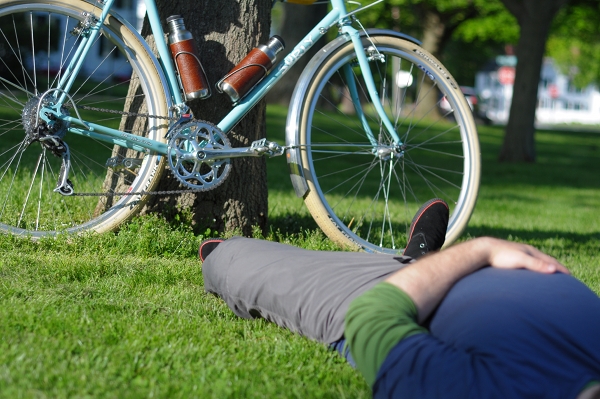 For the past month I've been cycling about 120 miles per week, not counting transportation. And as someone who is completely new to the concept of "training" (i.e. cycling with the goal to become faster, better uphill, and so on) I've been struggling with how to structure my rides. Last year the very notion of structure would have seemed completely ridiculous: I would simply go off on my bike whenever I had the time. But last year I never cycled the way I do now, never exerted myself to such an extent repeatedly. Now everything is different, and I feel completely lost in this new territory.
For the past month I've been cycling about 120 miles per week, not counting transportation. And as someone who is completely new to the concept of "training" (i.e. cycling with the goal to become faster, better uphill, and so on) I've been struggling with how to structure my rides. Last year the very notion of structure would have seemed completely ridiculous: I would simply go off on my bike whenever I had the time. But last year I never cycled the way I do now, never exerted myself to such an extent repeatedly. Now everything is different, and I feel completely lost in this new territory. With the Urbana bike temporarily in my possession and the Surly bikes we rode last week-end, I have suddenly undergone a crash course in threadless stems. Though of course I have seen them on bikes before, now I got to actually play around with one and understand it firsthand.
With the Urbana bike temporarily in my possession and the Surly bikes we rode last week-end, I have suddenly undergone a crash course in threadless stems. Though of course I have seen them on bikes before, now I got to actually play around with one and understand it firsthand. Of course the other major criticism of threadless stems is a practical one, and it is one with which I do agree: While quill stems can easily be raised and lowered to adjust handlebar height, threadless stems cannot. When buying a new frame meant for a threadless stem, there is a process (which I only half-understand), whereby you decide on the handlebar height you want, and they cut the steerer tube accordingly, then attach the threadless headset, spacers, and stem. After that, the handlebar height you chose is fixed, and it is not entirely clear to me what the options are, should you change your mind down the road and want the handlebars raised or lowered.
Of course the other major criticism of threadless stems is a practical one, and it is one with which I do agree: While quill stems can easily be raised and lowered to adjust handlebar height, threadless stems cannot. When buying a new frame meant for a threadless stem, there is a process (which I only half-understand), whereby you decide on the handlebar height you want, and they cut the steerer tube accordingly, then attach the threadless headset, spacers, and stem. After that, the handlebar height you chose is fixed, and it is not entirely clear to me what the options are, should you change your mind down the road and want the handlebars raised or lowered.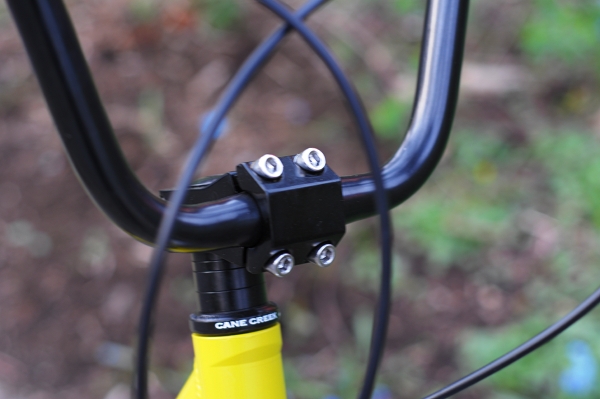 But while the lack of height adjustability is a drawback, I also discovered an unexpected benefit to the threadless stem: It is easier for me to work on. As mentioned before, I have problems with my hands that, frustratingly, make it mostly impossible for me to work on bikes. I know how to do most of the stuff and can give clear instructions to someone else, but typically lack the hand strength necessary to perform the operations myself. Not so with the Urbana bike. I first noticed that I was able to work on this bicycle, when we were putting it together and I tightened a bolt that I normally wouldn't have been able to. Later, I wanted to change the angle of the handlebars, so I watched this instructional video and did it - loosening and retightening the bolts with no problems. By contrast, I cannot even budge the bolt on a quill stem on my own. If threadless stems are generally easier to work on, then it's nice to have this bit of independence.
But while the lack of height adjustability is a drawback, I also discovered an unexpected benefit to the threadless stem: It is easier for me to work on. As mentioned before, I have problems with my hands that, frustratingly, make it mostly impossible for me to work on bikes. I know how to do most of the stuff and can give clear instructions to someone else, but typically lack the hand strength necessary to perform the operations myself. Not so with the Urbana bike. I first noticed that I was able to work on this bicycle, when we were putting it together and I tightened a bolt that I normally wouldn't have been able to. Later, I wanted to change the angle of the handlebars, so I watched this instructional video and did it - loosening and retightening the bolts with no problems. By contrast, I cannot even budge the bolt on a quill stem on my own. If threadless stems are generally easier to work on, then it's nice to have this bit of independence.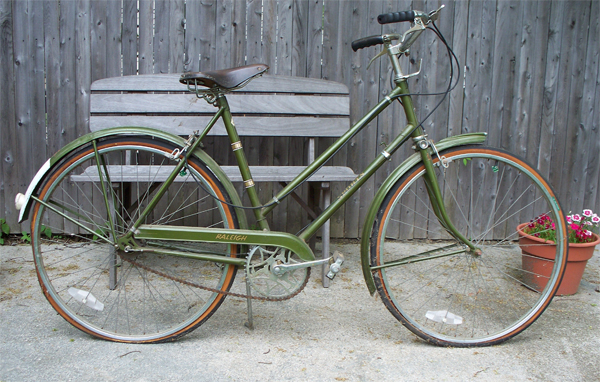 There was an old dusty bicycle lying around in my parents' garage when I was growing up. I had nearly forgotten it until they mentioned it recently. I asked my father to take some photos, not expecting anything special. Well, these are the photos he sent!
There was an old dusty bicycle lying around in my parents' garage when I was growing up. I had nearly forgotten it until they mentioned it recently. I asked my father to take some photos, not expecting anything special. Well, these are the photos he sent! I don't want to get my hopes up, but from the pictures the bicycle appears to be restorable. Look at that beautiful head badge!
I don't want to get my hopes up, but from the pictures the bicycle appears to be restorable. Look at that beautiful head badge!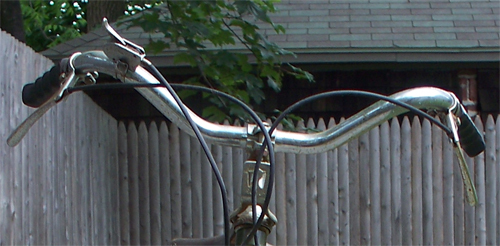 The brakes and the 3-speed gear shift (which I hope is the original Sturmey-Archer) look like they might be functional.
The brakes and the 3-speed gear shift (which I hope is the original Sturmey-Archer) look like they might be functional. The chain ring with the herons design! Of course the rusted out chain will need to be replaced.
The chain ring with the herons design! Of course the rusted out chain will need to be replaced. Decals are largely intact. The model can be identified as the Lady's Sports. Going by the information here, I am thinking it is late 60's-early'70s.
Decals are largely intact. The model can be identified as the Lady's Sports. Going by the information here, I am thinking it is late 60's-early'70s. Saddle is the Brooks B72, most likely original.
Saddle is the Brooks B72, most likely original.

 Taken from about a third of the way up the road.
Taken from about a third of the way up the road. A little further up the road with the road visible on the right. Steep drop-offs were the norm with guardrails in only some sections.
A little further up the road with the road visible on the right. Steep drop-offs were the norm with guardrails in only some sections. Nearing Logan Pass. This was taken from the Highline Trail. Construction along the highway can cause delays of up to half and hour in several different sections. It took me 1.5 hours to get to Logan Pass and another 1.5 hours to get to the east side entrance at St. Marys.
Nearing Logan Pass. This was taken from the Highline Trail. Construction along the highway can cause delays of up to half and hour in several different sections. It took me 1.5 hours to get to Logan Pass and another 1.5 hours to get to the east side entrance at St. Marys. A portion of the Highline trail on the left (in the shade), Going to the Sun Road winding up the hill, and Clements Mountain in the background.
A portion of the Highline trail on the left (in the shade), Going to the Sun Road winding up the hill, and Clements Mountain in the background. Wildflowers were in bloom, scattered here and there, clinging to the walls of the mountain.
Wildflowers were in bloom, scattered here and there, clinging to the walls of the mountain. Another view of the Going to the Sun Road and Clements Mountain. Waterfalls graced the sides of the valley – one can be seen in the lower right corner.
Another view of the Going to the Sun Road and Clements Mountain. Waterfalls graced the sides of the valley – one can be seen in the lower right corner.


















 We had some aviation training today and along the way, I was able to snap a few images.
We had some aviation training today and along the way, I was able to snap a few images. 




 A few days ago I borrowed a 7-speed Bella Ciao from Citybiker, and since I had my laptop bag with me I had to find a way to transport it. We looked for a basket that did not require complex installation and found one into which my bag could be stuffed, albeit with some effort.
A few days ago I borrowed a 7-speed Bella Ciao from Citybiker, and since I had my laptop bag with me I had to find a way to transport it. We looked for a basket that did not require complex installation and found one into which my bag could be stuffed, albeit with some effort. I was amused to notice that this basket is from the American manufacturer, Nantucket Bike Baskets, but rebranded by the German distributor Liix. Ah, globalisation.
I was amused to notice that this basket is from the American manufacturer, Nantucket Bike Baskets, but rebranded by the German distributor Liix. Ah, globalisation.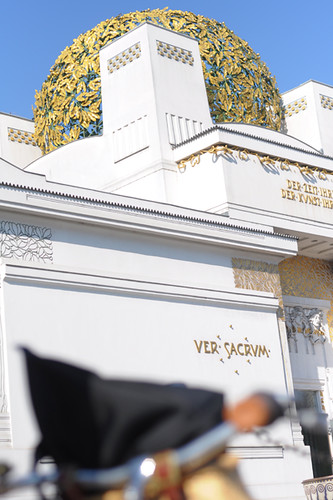 As a transport solution this setup worked well enough for the short trip, to the extent that my bag did not fall out and the handling of the bike was only mildly affected. But the experience made me remember the problems I have with handlebar-mounted baskets: (1) they tend to slide sideways along the handlebars, even when the basket is empty, and (2) when going over a bump, they bounce against the headtube.
As a transport solution this setup worked well enough for the short trip, to the extent that my bag did not fall out and the handling of the bike was only mildly affected. But the experience made me remember the problems I have with handlebar-mounted baskets: (1) they tend to slide sideways along the handlebars, even when the basket is empty, and (2) when going over a bump, they bounce against the headtube. For me this presents a dilemma, whereby one must choose between installing complicated (and heavy, and ugly) hardware to prevent the movement, or leaving it as is and cycling with a basket that is constantly sliding and bouncing. The later is annoying, but the former is a hassle. For this reason I like having a basket mounted on a front rack best, but a front rack does not make sense for every bike. I also realise that some just prefer the simplicity of a handlebar-mounted basket that can easily be attached and removed. In Vienna I do not often see cyclists with baskets attached to the handlebars via straps, and I think that is because of the cobblestones: Riding through some parts of the city, the bouncing would be unbearable. But I do see this method of attachment in Boston sometimes (though mostly on bikes that look like they are used for very short trips) and in photos from other countries.
For me this presents a dilemma, whereby one must choose between installing complicated (and heavy, and ugly) hardware to prevent the movement, or leaving it as is and cycling with a basket that is constantly sliding and bouncing. The later is annoying, but the former is a hassle. For this reason I like having a basket mounted on a front rack best, but a front rack does not make sense for every bike. I also realise that some just prefer the simplicity of a handlebar-mounted basket that can easily be attached and removed. In Vienna I do not often see cyclists with baskets attached to the handlebars via straps, and I think that is because of the cobblestones: Riding through some parts of the city, the bouncing would be unbearable. But I do see this method of attachment in Boston sometimes (though mostly on bikes that look like they are used for very short trips) and in photos from other countries. It occurred to me that if there were another set of holes in the back of the basket, toward the bottom, then a third strap could be fitted around the headtube and perhaps this would solve the problem. The design would be like a saddlebag in that regard, which has two straps on top to go around the saddle railings and another on the bottom to go around the seatpost. Has anyone ever tried this with a handlebar-mounted basket? I like the elegance and lack of commitment in attaching a basket via straps instead of clunky quick-release systems, decalleurs and the like. But for me, it needs to be practical - no sliding or bouncing.
It occurred to me that if there were another set of holes in the back of the basket, toward the bottom, then a third strap could be fitted around the headtube and perhaps this would solve the problem. The design would be like a saddlebag in that regard, which has two straps on top to go around the saddle railings and another on the bottom to go around the seatpost. Has anyone ever tried this with a handlebar-mounted basket? I like the elegance and lack of commitment in attaching a basket via straps instead of clunky quick-release systems, decalleurs and the like. But for me, it needs to be practical - no sliding or bouncing.

 Well, well. For some reason, Kinexxions has been included in the MyHeritage Top 100 Genealogy Sites list.
Well, well. For some reason, Kinexxions has been included in the MyHeritage Top 100 Genealogy Sites list.